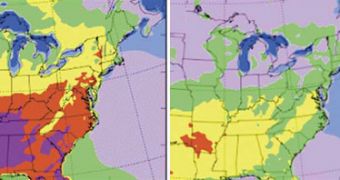Global warming may still seem a remote concept for you, but our grandsons will experience tropical summers on very temperate latitudes.
NASA researchers say that global warming could raise average summer temperatures in the eastern United States with 10 degrees Fahrenheit (5.5 degrees C) by the 2080s.
"There is the potential for extremely hot summertime temperatures in the future, especially during summers with less-than-average frequent rainfall," said lead author Barry Lynn of NASA's Goddard Institute for Space Studies and Columbia University, New York.
In eastern U.S. summer daily high temperatures, currently averaging around 27 degrees C (80 degrees Fahrenheit) would rise to around 32.2 degrees C (90 degrees Fahrenheit) by the 2080s.
In the extreme months, with infrequent rainfalls (July and August) daily high temperatures could reach 100 to 110 degrees Fahrenheit (37.7 to 43.3 degrees C) in cities like Chicago, Washington and Atlanta.
The computer simulations are based on about 30 years of observational temperature and precipitation data that have taken into account soil, atmospheric and oceanic factors plus future changes in greenhouse gases.
The weather model showed that extreme summertime surface temperatures developed when carbon dioxide emissions were assumed to continue to increase about 2 % per year, the "business as usual" scenario.
This model details future climate at a smaller geographic scale, more practical than global models, with reliable simulations on summer precipitation, but also their frequency and timing. Observational climate data also revealed that sea surface temperatures in the Pacific Ocean influenced significantly the summer air temperatures in the eastern U.S.
"Relatively cool waters in the eastern Pacific often result in stubborn summer high-pressure systems over the eastern states that block storms, reducing the frequency of precipitation below normal," noted study co-author Richard Healy of the Woods Hole Oceanographic Institution, Woods Hole, Mass.
"Less frequent storms result in higher surface and atmospheric temperatures that then feedback on the atmospheric circulation to further reduce storm frequency and raise surface temperatures even more."
"Since the weather prediction model simulated the frequency and timing of summer precipitation more reliably than the global model, its daily high temperature predictions for the future are also believed to be more accurate," added co-author Leonard Druyan, NASA Goddard Institute for Space Studies and Columbia University.
Many previous global models forecast too much rainfall that often occurs too early during the day, underestimating future warming levels by reflecting solar radiation back to space before it can warm the surface and depicting an excessive evaporation from the wet ground.
"Using high-resolution weather prediction models, we were able to show how greenhouse gases enhance feedbacks between precipitation, radiation, and atmospheric circulations that will likely lead to extreme temperatures in our not so distant future," said Lynn.

 14 DAY TRIAL //
14 DAY TRIAL //